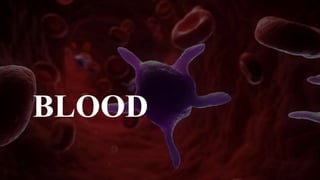
Blood, Blood Plasma and Blood group systems
- 1. BLOOD
- 2. Table of Contents: Introduction Blood group systems ABO Blood Group System Blood Plasma Blood cells and cell like bodies Blood transfusions in ABO blood group system
- 3. Introduction Blood is a specialized body fluid that is composed of a liquid called blood plasma and blood cells The weight of blood in our body is about 1/12th of our body The average adult body has about 5 liters of blood In a healthy person plasma constitutes about 55% by volume of blood, and cells or cell like bodies are about 45% by volume of the blood
- 4. BLOOD GROUP SYSTEMS Blood group systems are a classification of blood based on the presence or absence of antigens on the surface of red blood cells An antigen is a molecule that can stimulate an immune response
- 5. ABO Blood Group System It was discovered by the Austrian scientist Karl Landsteiner, who found four different blood groups (blood types) in 1900 He was awarded the Nobel Prize in Medicine for his work In this system, there are four different blood groups which are distinct from each other on the basis of specific antigens (antigen A and B) present on the surface of RBCs
- 6. ABO Blood Group System A person having antigen A has blood group A, a person having antigen B has blood group B, a person having both antigens has blood group AB, and a person 5 having none of the A and B antigens has blood group O After birth, two types of antibodies i.e anti-A & anti-B antibodies appear in the blood serum of individuals These antibodies are present according to the absence of corresponding antigen
- 7. ABO Blood Group System In persons with blood group A, antigen A is present and antigen B is absent So their blood will contain anti-B antibodies In persons with blood group B, antigen B is present and antigen A is absent So their blood will contain anti-A antibody A total of 29 human blood group systems are now recognized by the International Society of Blood Transfusion (ISBT)
- 8. ABO Blood Group System In persons with blood group AB, antigens A & B are present i.e. neither is absent So their blood serum will contain no antibody In persons with blood group O, neither antigen A nor antigen B is present i.e. both are absent So their blood serum will contain both antibodies i.e. anti-A & anti- B
- 10. BLOOD PLASMA Plasma is primarily water in which proteins, salts, metabolites and wastes are dissolved Water constitutes about 90-92% of plasma and 8- 10% are dissolved substances Salts make up 0.9 % of plasma, by weight. Sodium chloride and salts of bicarbonates are present in considerable amounts Ca, Mg, Cu, K and Zn are found in trace amounts Changes in the concentration of any salt can change the pH of blood (normal is 7.4)
- 11. BLOOD PLASMA Proteins make 7-9 % by weight of plasma The important proteins present in plasma are antibodies, fibrinogen (blood clotting protein), albumin (maintains the water balance of blood) etc Plasma also contains the digested food (absorbed from digestive system), nitrogenous wastes and hormones Respiratory gases i.e. CO2 and O2 are present in the plasma
- 12. BLOOD CELLS AND CELL-LIKE BODIES These include: Red blood cells (erythrocytes) White blood cells (leukocytes) Platelets (thrombocytes).
- 13. Red Blood Cells (Erythrocytes) These are the most numerous of blood cells A cubic millimeter of blood contains 5 to 5.5million of RBCs in males, and 4 to 4.5 million in females About 95% of the cytoplasm of RBCs is filled with hemoglobin, which transports O2 and small amounts of CO2 The remaining 5% consists of enzymes, salts and other proteins
- 14. Red Blood Cells (Erythrocytes) Average life span of RBC is about four months (120 days) after which it breaks down in liver and spleen by phagocytosis In a normal person about 2-10 million red blood cells are formed and destroyed every second
- 15. White Blood Cells (Leukocytes) These are colorless, because they do not contain pigments They are not confined to blood vessels and also migrate out into tissue fluid One cubic millimeter of blood contains 7000 to 8000 WBCs Their life span ranges from months to even years, depending on body’s needs WBCs function as the main agents in body’s defence system
- 16. Platelets (Thrombocytes) They are not cells, but are fragments of large cells of bone marrow, called megakaryocytes They do not have any nucleus and any pigment One cubic millimeter of blood contains 250,000 platelets The average life span of a blood platelet is about 7 to 8 days Platelets help in blood clotting The clot serves as a temporary seal at the damaged area
- 17. Blood transfusion Blood transfusion is the process of transferring blood or blood-based products from one person into the circulatory system of another Blood transfusions can be lifesaving in some situations, such as massive blood loss due to injury, or can be used to replace blood lost during surgery
- 18. Blood transfusion People suffering from anemia, hemophilia, thalassemia or sickle- cell disease may require frequent blood transfusions A number of infectious diseases (such as AIDS, hepatitis B and hepatitis C etc.) can pass from the affected blood donor to recipient Before blood transfusion, the blood of donor is checked for the presence of germs etc
